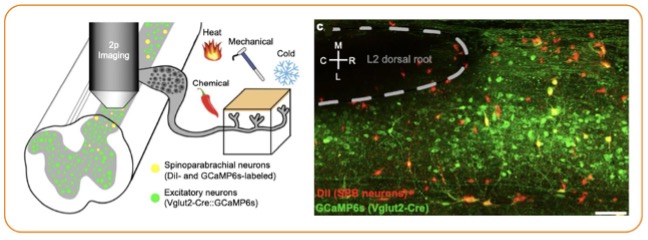
Stories

Sarah Ross, Faculty in the Center for Neuroscience. Photo credit: University of Pittsburgh
Sarah Ross: Embracing Agility to Catalyze Discovery
“The parts I love about science are the opportunities to discover and mentor. The biggest highlight for a scientist is when we can combine the two—working with trainees who make discoveries,” explains Sarah Ross as she reflects on her accomplishments as a pain researcher. Ross has followed the career path she dreamed of as a child. Growing up, she always wanted to teach science at the college level, understanding that achieving this goal would require a doctoral degree. “I didn’t realize how much I would like it until I was really doing it, and I just fell in love,” she says.
This passion for discovery has guided Ross through multiple scientific pivots, from studying cell development to groundbreaking research in pain and itch studies. Ross received her bachelor’s degree from the University of Western Ontario before earning her doctorate at the University of Michigan in a lab that studied fat cells and fat cell differentiation. At the time, her research focused on the role of lithium in preventing fat cell differentiation, “I hypothesized that lithium inhibited the phosphorylation of a transcription factor, which impacts its activity and blocks fat cell differentiation,” she recalls. What seemed like a straightforward research question led to a eureka moment, shaping her approach to science.
Ross remembers, “I went to this scientific meeting, a Keystone Symposia on Molecular and Cellular Biology. There, I learned about wingless-related integration site (WNT) signaling—a pathway that regulates cell fate and differentiation for the first time.” The WNT signaling pathway has several components, including kinases enzymes that regulate the activity of other proteins like transcription factors through phosphorylation or the transfer of high-energy phosphate groups.
“I suddenly thought, what if lithium was inhibiting the activity of the kinase in fat cells. It was one of those moments where everything fell into place, and I realized it was actually WNT signaling that was regulating the development of fat cells and helping to decide between a precursor becoming fat, muscle, or bone. That was one of the most exciting moments in my career as a graduate student. Thinking of it all through one lens and realizing that’s completely wrong. It’s this other lens.” With guidance and encouragement from her mentor, Ormond A. MacDougald, and John A. Faulkner, Collegiate Professor of Molecular & Integrative Physiology at the University of Michigan, Ross followed her instincts to further investigate the connections between lithium and phosphorylation.
This key insight about scientific perspective-taking would prove crucial in Ross’s next unexpected discovery. As a postdoctoral fellow at Harvard Medical School, Ross discovered an unusual connection between a mouse model and chronic itch. “I started studying itch in a very accidental way. I was studying a transcription factor that we thought was going to be very important for the development of the cortex—a region of the brain—and it is. But when we made the mouse that was lacking this transcription factor the major thing that was wrong with this mouse, it developed these self-inflicted skin lesions. These mice had been licking these specific areas of the skin, and it was just the most striking phenotype. It was hard not to study that part.” Ross and her team used conditional ablation and fate mapping, which track how cells develop into organs and tissues, to uncover the cause: a subset of spinal cord neurons that inhibit itch was missing in these abnormally itchy mice.
The timing of these findings was critical for the direction that Ross would take her research. “We made the itch circuit discovery relatively late during my post-doctoral work, and when I was thinking about what to do next, I decided I wanted to study them further. It took my work in a completely new direction, but it wasn’t where I’d had a vast amount of training.” Despite not having much background in the field of itch, Ross followed her instincts and was warmly welcomed by a small community of researchers. This discovery laid the foundation for her research into pain and itch circuits and the start of her own lab.
This willingness to pursue unexpected findings has become central to her scientific philosophy. Ross emphasizes the importance of challenging established ideas in science. “One lesson I pass to my students is not to accept dogma as fact. Considering different perspectives is essential to uncovering the truth.”
In 2012, Ross received the Rita Allen Foundation Scholar Award in Pain, which proved transformative for her career journey. As a newcomer to the field, the award not only provided crucial funding for her research goals but also helped her build lasting connections within the pain and itch research community. Ross’s lab made exciting discoveries about how certain drugs, called kappa opioid receptor (KOR) agonists, can stop itch at its source.
One of the most significant papers funded by the award revealed the fate of the neurons that Ross had previously shown were responsible for the increased itch. It turned out that these neurons express dynorphin in the superficial dorsal horn, the endogenous agonist for the kappa opioid receptor (KOR), and were crucial for KOR activity.
Ross’ lab made exciting discoveries about how drugs called kappa opioid receptor (KOR) agonists, can stop itch at its source. KOR agonists are the only clinically approved drugs for the treatment of itch in many countries. In 2024, Ross’ lab published a study showing that these drugs work by calming down specific nerve cells in the spinal cord that send itch signals to the brain. These nerve cells have a unique receptor called GRPR, which is key to how we feel itch. Using cutting-edge imaging techniques, the research revealed that KOR agonists target only these itch-related cells without affecting others, making them a promising treatment for stubborn itching conditions where options are currently limited.
Now an Associate Professor at the University of Pittsburgh, Ross studies the neural circuits that underlie sensory integration using electrophysiological, behavioral, and optogenetic techniques. Her research spans how sensory input is processed, how injury alters these circuits, and how pain and itch intertwine.
Ross explains, “My lab is interested in two directions right now. One is that we think of the dorsal horn, the top part of the spinal cord, the part closest to your back, as the region that is getting all of this sensory input and integrating it. But we don’t know any of the rules for how this works. So, one of the big things that my lab is trying to do is look at the activity of all the neurons in that region simultaneously using calcium imaging. We have a preparation model where we have control of the input at the skin. We’re looking at the activity of hundreds of neurons in the spinal cord that are integrating this activity. We can see the activity in the spinal output neurons conveying the information to the brain. Now we have the information to start decoding what the dorsal horn is doing with this information to integrate it—what those rules are in a regular naïve animal and how those rules change in the context of injury.”
On the connection between pain and itch, Ross expands, “The other research interest of my lab is following up on the concept that pain and itch are just two types of sensory input that are telling you how your body is at every moment in time—that how you feel physically integrated with information about how you feel emotionally. Because what you feel physically and how you feel mentally are intertwined at the level of the neurocircuits in the brain, I believe that there is such a substantial comorbidity between things like chronic pain, depression, and other affective states. To understand either of those conditions, we must understand the other and study them together.”
Here, Ross shares how the Rita Allen Award in Pain influenced her career trajectory, the challenges she has faced in her research career, and the impact of emerging technology on pain and itch.
How has the award from the Rita Allen Foundation influenced your career trajectory?
The first few publications that came out of our lab were funded by the Rita Allen Award and the one that is the most notable is the Kardon et al. paper. We knew that the mice that were lacking this specific population of neurons had elevated itch (mentioned previously). In that follow up paper, we discovered what those neurons turned into in the adult animal. It turns out that those neurons are the neurons that express dynorphin in the superficial dorsal horn and dynorphin is the endogenous agonist, or initiator, for the kappa opioid receptor. Kappa opioid receptor agonists are, in other countries of the world, the only clinically approved drug for the treatment of itch.

What are the biggest challenges you have faced in your research and how have you approached those challenges?
I’d say one of the things that I learned as a P.I. that I think was really helpful to me is that you can’t please everybody and you shouldn’t try to. For example, when you write a grant proposal, you need to show it to a bunch of people before you submit it. You might show it to 10 people, and 10 people are going to tell you to change it in 10 different ways—you can’t make everybody happy. You just have to think about all their advice and pick one or two that really resonate with you. Go with it and not worry about the rest. You can’t make everybody happy.
Can you speak a little bit to how new and emerging technology has impacted your work and your research, and specifically if you can also touch on how those changes maybe have changed the way you view your science or how you approach your science?
I can say for sure that whatever you’re doing during your Ph.D. in is not what you’re going to be doing when you’re a post doc and when you’re a faculty member. As a graduate student, I was doing lots of things like western blots. As a post doc we were doing genomic manipulation. Now the people in my lab are doing things that I’ve never done before. I think that’s just generally how things work because there are new approaches that are being developed all the time. You have to be ready to be flexible and out of your comfort zone and learn new things all the time—it makes science both intimidating and exciting. Just go in with the idea that you’re going to be able to figure it out and start learning.